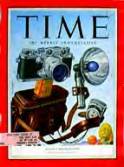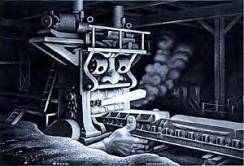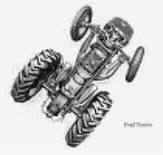 |
 |
||
This is a great web site containing information about Boris Artzybasheff and images included in this lesson.
"Artzy" Art during World War II
Lesson #5
Lesson 5 station information sheet
Lesson 5 Student Scavenger Hunt
Anthropomorphic
Images and Boris Artzybasheff
Description:
In
this lesson students have an opportunity to learn more about the artist Boris
Artzybasheff and his artwork through an informative scavenger hunt.
Students will also have an opportunity to produce a piece of
anthropomorphic art.
Subject: Fine
Arts, Social Sciences
Duration: 100 min. (aprox.)
Grade
Levels: 8-12
Standards:
TX-113.24.a.4.b.8.32.B
TSIET... use a decision-making process to identify a situation
that requires a decision, gather
information, identify options, predict consequences, and take action to
implement a decision.
TX-113.32.c.26.A
TSIET... use a problem-solving process to identify a problem, gather
information, list and consider options, consider advantages and disadvantages,
choose and implement a solution, and evaluate the effectiveness of the solution.
TX-113.36.c.10.B
TSIET...
identify elements of social learning theory in modern advertising.
TX-113.37.c.8.C
TSIET...
evaluate different communication techniques, including propaganda and
advertising, used to influence perceptions, attitudes, and behaviors of persons
and groups.
TX-117.38.b.2
By analyzing artistic styles and historical periods students develop
respect for the traditions and contributions of diverse cultures. Students
respond to and analyze artworks, thus contributing to the development of
lifelong skills of making informed judgments and evaluations.
TX-117.56.c.4
The student demonstrates an understanding of cultural, historical,
and artistic diversity.
Resources:
·
The
University of North Texas Library. They
supplied the images of Artzybasheff’s World War II advertisement posters.
·
http://www.bpib.com/artzybas.htm


This is a great web
site containing information about Boris Artzybasheff and images included in this
lesson.
·
http://www.adh.brighton.ac.uk/schoolofdesign/MA.COURSE/01/LIAArtzybasheff.html

This is another great
web site containing information about Boris Artzybasheff and images included in
this lesson.
·
http://www.eisnermuseum.org/_artzybashoff/main.html
This is the web site for the
Eisner Museum and it contains an on-line exhibit of some of Boris
Artzybasheff’s work.
·
http://www.enter.net/~torve/art/artzy/artzy.html

This site contains some
information about the artist and some pictures of his artwork.
Vocabulary:
·
Anthropomorphic
Attribution of human motivation,
characteristics, or behavior to inanimate objects, animals, or natural
phenomena. {Source:
The American Heritage Dictionary of
the English Language. Fourth
Edition. Houghton Miffin
Company. 2000 – provided by
Dictionary.com}
·
Advertisement
A notice, such as a poster or a paid announcement in the print, broadcast, or electronic media, designed to attract public attention or patronage.
{Source: The
American Heritage® Dictionary of the English Language, Fourth Edition. Houghton Mifflin Company.
2000 – provided by Dictionary.com}
Goal:
This
unit of instruction is engineered to teach the students that there is a give and
take relationship between art, and the culture and time period in which it was
created. This lesson reinforces
that idea by allowing the student an opportunity to become more familiar the
artist Boris Artzybasheff and his artwork. Hopefully students will be able to
recognize information presented in previous lessons in Artzybasheff’s
anthropomorphic images.
Objectives:
·
The
student will learn more about the artist Boris Artzybasheff through an
informative scavenger hunt.
·
The
student will learn more about the art of Boris Artzybasheff through an
informative scavenger hunt.
·
The
student will gain a deeper understanding of the term anthropomorphic through an
informative scavenger hunt.
·
The
learner will demonstrate an understanding of the term anthropomorphic by
producing a piece of anthropomorphic artwork.
Motivation:
Bring
out the Boris Artzybasheff image that we looked at initially in the first
lesson. Ask the students if they remember some of the things they have discussed
about this piece of artwork. Review
all of the previous lessons with the students.
In
the first lesson the students did not know anything about the work of art or the
artist and they were asked to really look deeply at the image and for some
hypotheses.
The
second lesson of this unit discussed the many perspectives of World War II. In that lesson students were asked to revisit the Atzybasheff
image and talk about what perspectives were applicable to that piece of artwork.
In
the third lesson students learned about metaphor.
In that lesson students were asked to revisit the Artzybasheff image and
look for possible metaphors based on their knowledge of literary metaphor and
World War II.
In
the fourth lesson students learned about cartooning and anthropomorphic images
related to World War II.
Review
with the students all the information they have gathered about the artwork of
Artzybasheff. Remind the students
that they really have not learned much about Artzybasheff himself or the other
works of art he had created.
Explain
to the students that they are going to go on a scavenger hunt of sorts to gather
more information about the artist Boris Artzybasheff and his artwork.
Procedure:
1.
Have your
classroom set up with five scavenger hunt stations.
(A packet for each stations, including images, is attached at the end of
this lesson.) The students should be divided into five groups and
each group will eventually rotate around to each station.
As the student rotate to each station they will need to collect
information on their ‘student scavenger hunt sheet’ (The ‘student
scavenger hunt sheet’ is at the end of this lesson.)
Also, as the students rotate play WWII era music and instruct the
students to move to the next station clockwise when the music stops.
Station
1 A General Information
Station…
This station should provide the students with basic information about Artzybasheff like where he was from and when he lived. What did he do for a living? Included is a picture of the artist. The students will use the computer and provided web sites to compile this data.
Station 2 Other
advertisements from Time magazine during WW II.
This station should contain three
to four images that meet the above criteria.
The ‘student scavenger hunt sheet’ asks the student to compare and
contrast these images with the Artzybasheff image from the first lesson.
Station 3 Other
Artzybasheff advertisement, post World War II.
This station includes images from Artzybasheff advertisements after World War II and asks students to compare and contrast them to his during WWII advertisements. What is similar? What is different?
Station 4 Time
Magazine Covers
This station includes copies of a
few of his magazine covers. Students
are asked to look at these to see if they have anything in common with the other
Artzybasheff images they have seen. Is
there anything totally different about them?
Station
5 Book Illustrations
This station presents information about his book illustrations and examples of the illustrations. Once again students will be asked to look at these illustration and compare / contrast them with the Artzybasheff images they have seen.
2.
Have
the students reconvene and discuss their findings during the scavenger hunt as a
class. Use the ‘student scavenger
hunt sheet’ as a guide for the discussion.
Also during this discussion refer back Artzybasheff image from the first
lesson in this unit and the brainstorming sheet. Work with the students to see if they need to add any or
remove any information.
3.
The
students are now going to going to produce their own piece of anthropomorphic
art. The students are to first pick
a machine or piece of machinery to start with.
This can be done several ways. The
teacher can write names of machines or machinery on pieces of paper and the
students pick them out of a hat. The
teacher can provide several pictures of machines or machinery and the students
can select an image. Or the teacher
can bring actual pieces of machinery to class.
Examples might be a screw, a wrench, a model car or a spring.
4.
The
students will draw a total of four pictures.
Picture
1 This is a drawing of the machine or piece of machinery
Picture 2 This is a drawing of the machine or machinery with
characteristics
of the human.
Picture 3 This is a drawing of the
human with characteristics of the
machine.
Picture 4 This is drawing of the human in a position similar to the
shape
of the machine. The students should be able to imagine the transformation at this point.
This works best if the drawings
are NOT done in order! Picture 1, the machine, should be drawn first.
The second drawing should be Picture
4, the human in a position similar to the shape of the machine.
The students should be able to imagine or visualize how this
transformation is going to take place. Next
the students should draw Picture 2 and
then Picture 3. The students will then have two anthropomorphic
drawings, picture 2 and 3.
Assessment:
A
portion of this lesson requires the student to go on an informative scavenger
hunt. The level at which the
student performs on the ‘student scavenger hunt sheet’ and contributes to
class discussion will indicate the level at which the student thought about the
information that was presented. (Refer to the rubric at the end of this lesson.)
Another
portion of this lesson required the student to produce an anthropomorphic
drawing. The level at which the
student met the requirements of the assignment indicates the student’s
understanding of the term
anthropomorphic.
(Refer to the rubric at the end of this unit.)
Materials:
·
A
scavenger hunt packet of each of the scavenger hunt stations.
(A copy of each of these, including images, is at the end of this
lesson.)
·
Each
student should get a copy of the ‘student scavenger hunt sheet.
(A copy of this is at the end o the lesson.)
·
Each
student will need 4 sheet of white drawing paper, either 12in. x 18in. each or
6in. x 9in. each.
·
Colored
pencils or any other medium if the teacher wishes for the students to add color
to the drawings.
Background:
This lesson requires some background knowledge about Boris Artzybasheff.
He was born in Russia and immigrated at the age of 23 in 1922.
Unable to speak English he came to New York and worked in an engraving
shop on ornamental borders. He then
became a merchant seaman and saved his earnings to then set up shop as a
professional artist and designer. During
World War II he served as an expert advisor to the U.S. Department of State,
Psychological Welfare branch.
During his career he designed over
200 covers for Time magazine, illustrated over 50 books most of which he
illustrated and drew an amazing number of illustrations for advertisements for
mechanical goods.
Artzybasheff had a wide range of artistic
abilities. He could draw the most
realistic of images to images that are very cartoon like.
Most of his images are anthropomorphic.
These anthropomorphic images have such character and whit about them.
Arzybasheff is best known for his magazine covers but his other images
are gaining in popularity. Boris
Artzybasheff died in 1965.
Lesson
by Sandra S. Newton